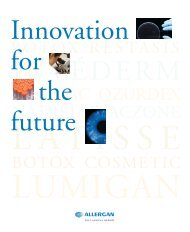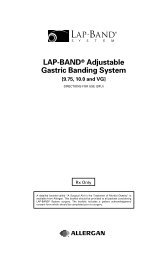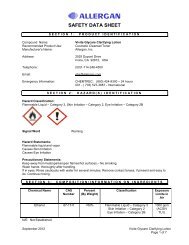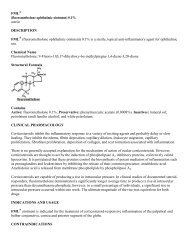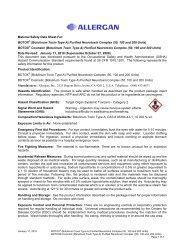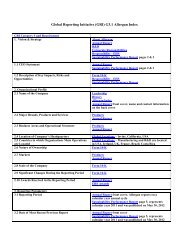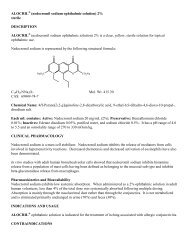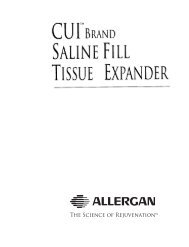TAZORAC (tazarotene) Gel 0.05% - Allergan
TAZORAC (tazarotene) Gel 0.05% - Allergan
TAZORAC (tazarotene) Gel 0.05% - Allergan
You also want an ePaper? Increase the reach of your titles
YUMPU automatically turns print PDFs into web optimized ePapers that Google loves.
<strong>TAZORAC</strong> ®<br />
(<strong>tazarotene</strong>) <strong>Gel</strong>, <strong>0.05%</strong><br />
(<strong>tazarotene</strong>) <strong>Gel</strong>, 0.1%<br />
FOR DERMATOLOGIC USE ONLY<br />
NOT FOR OPHTHALMIC, ORAL, OR INTRAVAGINAL USE.<br />
DESCRIPTION<br />
<strong>TAZORAC</strong> ® <strong>Gel</strong> is a translucent, aqueous gel and contains the compound <strong>tazarotene</strong>, a member of the<br />
acetylenic class of retinoids. It is for topical dermatologic use only. The active ingredient is represented by the<br />
following structural formula:<br />
Formula: C 21 H 21 NO 2 S<br />
Molecular Weight: 351.46<br />
Chemical Name: Ethyl 6-[(4,4-dimethylthiochroman-6-yl)ethynyl]nicotinate<br />
Contains:<br />
Active: Tazarotene <strong>0.05%</strong> or 0.1% (w/w)<br />
Preservative: Benzyl alcohol 1% (w/w)<br />
Inactives: Ascorbic acid; butylated hydroxyanisole; butylated hydroxytoluene; carbomer homopolymer type B;<br />
edetate disodium; hexylene glycol; poloxamer 407; polyethylene glycol 400; polysorbate 40; purified water;<br />
and tromethamine.<br />
CLINICAL PHARMACOLOGY<br />
Tazarotene is a retinoid prodrug which is converted to its active form, the cognate carboxylic acid of <strong>tazarotene</strong><br />
(AGN 190299), by rapid deesterification in animals and man. AGN 190299 (“tazarotenic acid”) binds to all<br />
three members of the retinoic acid receptor (RAR) family: RAR, RAR, and RAR but shows relative<br />
selectivity for RAR, and RAR and may modify gene expression. The clinical significance of these findings is<br />
unknown.<br />
Psoriasis: The mechanism of <strong>tazarotene</strong> action in psoriasis is not defined. Topical <strong>tazarotene</strong> blocks induction<br />
of mouse epidermal ornithine decarboxylase (ODC) activity, which is associated with cell proliferation and<br />
hyperplasia. In cell culture and in vitro models of skin, <strong>tazarotene</strong> suppresses expression of MRP8, a marker of<br />
inflammation present in the epidermis of psoriasis patients at high levels. In human keratinocyte cultures, it<br />
inhibits cornified envelope formation, whose build-up is an element of the psoriatic scale. Tazarotene also<br />
induces the expression of a gene which may be a growth suppressor in human keratinocytes and which may<br />
inhibit epidermal hyperproliferation in treated plaques. However, the clinical significance of these findings is<br />
unknown.<br />
Acne: The mechanism of <strong>tazarotene</strong> action in acne vulgaris is not defined. However, the basis of <strong>tazarotene</strong>’s<br />
therapeutic effect in acne may be due to its anti-hyperproliferative, normalizing-of-differentiation and anti-
inflammatory effects. Tazarotene inhibited corneocyte accumulation in rhino mouse skin and cross-linked<br />
envelope formation in cultured human keratinocytes. The clinical significance of these findings is unknown.<br />
Pharmacokinetics: Following topical application, <strong>tazarotene</strong> undergoes esterase hydrolysis to form its active<br />
metabolite, tazarotenic acid. Little parent compound could be detected in the plasma. Tazarotenic acid was<br />
highly bound to plasma proteins (greater than 99%). Tazarotene and tazarotenic acid were metabolized to<br />
sulfoxides, sulfones and other polar metabolites which were eliminated through urinary and fecal pathways. The<br />
half-life of tazarotenic acid was approximately 18 hours, following topical application of <strong>tazarotene</strong> to normal,<br />
acne or psoriatic skin.<br />
The human in vivo studies described below were conducted with <strong>tazarotene</strong> gel applied topically at<br />
approximately 2 mg/cm 2 and left on the skin for 10 to 12 hours. Both the peak plasma concentration (C max ) and<br />
area under the plasma concentration time curve (AUC) refer to the active metabolite only.<br />
Two single, topical dose studies were conducted using 14 C-<strong>tazarotene</strong> gel. Systemic absorption, as determined<br />
from radioactivity in the excreta, was less than 1% of the applied dose (without occlusion) in six psoriatic<br />
patients and approximately 5% of the applied dose (under occlusion) in six healthy subjects. One nonradiolabeled<br />
single-dose study comparing the <strong>0.05%</strong> gel to the 0.1% gel in healthy subjects indicated that the<br />
Cmax and AUC were 40% higher for the 0.1% gel.<br />
After 7 days of topical dosing with measured doses of <strong>tazarotene</strong> 0.1% gel on 20% of the total body surface<br />
without occlusion in 24 healthy subjects, the Cmax for tazarotenic acid was 0.72 ± 0.58 ng/mL (mean SD)<br />
occurring 9 hours after the last dose, and the AUC 0-24hr for tazarotenic acid was 10.1 ± 7.2 ng·hr/mL. Systemic<br />
absorption was 0.91 0.67% of the applied dose.<br />
In a 14-day study in five psoriatic patients, measured doses of <strong>tazarotene</strong> 0.1% gel were applied daily by<br />
nursing staff to involved skin without occlusion (8 to 18% of total body surface area; mean SD: 13 5%).<br />
The Cmax for tazarotenic acid was 12.0 7.6 ng/mL occurring 6 hours after the final dose, and the AUC 0-24hr<br />
for tazarotenic acid was 105 55 ng·hr/mL. Systemic absorption was 14.8 7.6% of the applied dose.<br />
Extrapolation of these results to represent dosing on 20% of total body surface yielded estimates for tazarotenic<br />
acid with Cmax of 18.9 10.6 ng/mL and AUC 0-24hr of 172 88 ng·hr/mL.<br />
An in vitro percutaneous absorption study, using radiolabeled drug and freshly excised human skin or human<br />
cadaver skin, indicated that approximately 4 to 5% of the applied dose was in the stratum corneum (<strong>tazarotene</strong>:<br />
tazarotenic acid = 5:1) and 2 to 4% was in the viable epidermis-dermis layer (<strong>tazarotene</strong>: tazarotenic acid = 2:1)<br />
24 hours after topical application of the gel.<br />
Clinical Studies<br />
Psoriasis: In two large vehicle-controlled clinical studies, <strong>tazarotene</strong> <strong>0.05%</strong> and 0.1% gels applied once daily<br />
for 12 weeks were significantly more effective than vehicle in reducing the severity of the clinical signs of<br />
stable plaque psoriasis covering up to 20% of body surface area. In one of the studies, patients were followed up<br />
for an additional 12 weeks following cessation of therapy with <strong>TAZORAC</strong> ® <strong>Gel</strong>. Mean baseline scores and<br />
changes from baseline (reductions) after treatment in these two studies are shown in the following table:<br />
Plaque Elevation, Scaling, and Erythema in Two Controlled Clinical Trials for Psoriasis<br />
<strong>TAZORAC</strong> ® <strong>0.05%</strong> <strong>Gel</strong> <strong>TAZORAC</strong> ® 0.1% <strong>Gel</strong> Vehicle <strong>Gel</strong><br />
Trunk/Arm/Leg<br />
Lesions<br />
Knee/Elbow<br />
Lesions<br />
Trunk/Arm/Leg<br />
Lesions<br />
Knee/Elbow<br />
Lesions<br />
Trunk/Arm/Leg<br />
Lesions<br />
Knee/Elbow<br />
Lesions<br />
N=108 N=111 N=108<br />
N=<br />
111<br />
N=108 N=112 N=108 N=112 N=108 N=113 N=108 N=113<br />
Plaque B* 2.5 2.6 2.6 2.6 2.5 2.6 2.6 2.6 2.4 2.6 2.6 2.6
Elevation<br />
Scaling<br />
Erythema<br />
C-12*<br />
C-24*<br />
B*<br />
C-12*<br />
C-24*<br />
B*<br />
C-12*<br />
C-24*<br />
-1.4<br />
-1.2<br />
2.4<br />
-1.1<br />
-0.9<br />
2.4<br />
-1.0<br />
-1.1<br />
-1.3 -1.3<br />
-1.1<br />
2.5 2.5<br />
-1.1 -1.1<br />
2.7<br />
-0.8<br />
-0.8<br />
2.2<br />
-0.9<br />
-0.7<br />
-1.1 -1.4<br />
-1.1<br />
2.6 2.4<br />
-0.9 -1.3<br />
2.5<br />
-0.8<br />
-1.0<br />
2.4<br />
-1.0<br />
-0.9<br />
-1.4 -1.5<br />
-1.0<br />
2.6 2.5<br />
-1.3 -1.2<br />
2.8<br />
-1.1<br />
-0.8<br />
2.3<br />
-1.0<br />
-0.8<br />
-1.3 -0.8<br />
-0.9<br />
2.7 2.4<br />
-1.2 -0.7<br />
2.5<br />
-0.8<br />
-0.8<br />
2.3<br />
-0.6<br />
-0.7<br />
-0.7 -0.7<br />
-0.7<br />
2.6 2.5<br />
-0.7 -0.6<br />
Plaque elevation, scaling, and erythema scored on a 0-4 scale with 0=none, 1=mild, 2=moderate, 3=severe and<br />
4=very severe.<br />
B*=Mean Baseline Severity: C-12*=Mean Change from Baseline at end of 12 weeks of therapy:<br />
C-24*=Mean Change from Baseline at week 24 (12 weeks after the end of therapy).<br />
Global improvement over baseline at the end of 12 weeks of treatment in these two studies is shown in the<br />
following table:<br />
<strong>TAZORAC</strong>® <strong>0.05%</strong> <strong>Gel</strong> <strong>TAZORAC</strong>® 0.1% <strong>Gel</strong> Vehicle <strong>Gel</strong><br />
N=81 N=93 N=79 N=69 N=84 N=91<br />
100% improvement 2 (2%) 1 (1%) 0 0 1 (1%) 0<br />
≥75% improvement 23 (28%) 17 (18%) 30 (38%) 17 (25%) 10 (12%) 9 (10%)<br />
≥50% improvement 42 (52%) 39 (42%) 51 (65%) 36 (52%) 28 (33%) 21 (23%)<br />
1-49% improvement 21 (26%) 32 (34%) 18 (23%) 23 (33%) 27 (32%) 32 (35%)<br />
No change or worse 18 (22%) 22 (24%) 10 (13%) 10 (14%) 29 (35%) 38 (42%)<br />
The 0.1% gel was more effective than the <strong>0.05%</strong> gel, but the <strong>0.05%</strong> gel was associated with less local irritation<br />
than the 0.1% gel (see ADVERSE REACTIONS section).<br />
Acne: In two large vehicle-controlled studies, <strong>tazarotene</strong> 0.1% gel applied once daily was significantly more<br />
effective than vehicle in the treatment of facial acne vulgaris of mild to moderate severity. Percent reductions in<br />
lesion counts after treatment for 12 weeks in these two studies are shown in the following table:<br />
Reduction in Lesion Counts after Twelve Weeks of Treatment in Two Controlled Clinical Trials for Acne<br />
<strong>TAZORAC</strong> ® 0.1% <strong>Gel</strong> Vehicle <strong>Gel</strong><br />
N=150 N=149 N=148 N=149<br />
Noninflammatory lesions 55% 43% 35% 27%<br />
Inflammatory lesions 42% 47% 30% 28%<br />
Total lesions 52% 45% 33% 27%<br />
Global improvement over baseline at the end of 12 weeks of treatment in these two studies is shown in the<br />
following table:<br />
<strong>TAZORAC</strong> ® 0.1% <strong>Gel</strong> Vehicle <strong>Gel</strong><br />
N=105 N=117 N=117 N=110<br />
100% improvement 1 (1%) 0 0 0<br />
≥75% improvement 40 (38%) 21 (18%) 23 (20%) 11 (10%)<br />
≥50% improvement 71 (68%) 56 (48%) 47 (40%) 32 (29%)<br />
1-49% improvement 23 (22%) 49 (42%) 48 (41%) 46 (42%)<br />
No change or worse 11 (10%) 12 (10%) 22 (19%) 32 (29%)<br />
INDICATIONS AND USAGE<br />
2.7<br />
-0.5<br />
-0.7<br />
2.2<br />
-0.5<br />
-0.6<br />
-0.6<br />
2.7<br />
-0.6<br />
2.5<br />
-0.5
<strong>TAZORAC</strong> ® (<strong>tazarotene</strong>) <strong>Gel</strong> <strong>0.05%</strong> and 0.1% are indicated for the topical treatment of patients with stable<br />
plaque psoriasis of up to 20% body surface area involvement.<br />
<strong>TAZORAC</strong> ® (<strong>tazarotene</strong>) <strong>Gel</strong> 0.1% is also indicated for the topical treatment of patients with facial acne<br />
vulgaris of mild to moderate severity.<br />
The efficacy of <strong>TAZORAC</strong> ® <strong>Gel</strong> in the treatment of acne previously treated with other retinoids or resistant to<br />
oral antibiotics has not been established.<br />
CONTRAINDICATIONS<br />
Retinoids may cause fetal harm when administered to a pregnant woman.<br />
In rats, <strong>tazarotene</strong> <strong>0.05%</strong> gel, administered topically during gestation days 6 through 17 at 0.25 mg/kg/day<br />
(1.5 mg/m 2 /day) resulted in reduced fetal body weights and reduced skeletal ossification. Rabbits dosed<br />
topically with 0.25 mg/kg/day (2.75 mg/m 2 total body surface area/day) <strong>tazarotene</strong> gel during gestation days 6<br />
through 18 were noted with single incidences of known retinoid malformations, including spina bifida,<br />
hydrocephaly, and heart anomalies. Systemic daily-exposure (AUC de ) to tazarotenic acid at topical doses of<br />
0.25 mg/kg/day <strong>tazarotene</strong> in a gel formulation in rats and rabbits represented 0.62 and 6.7 times, respectively,<br />
the AUC 0-24h observed in psoriatic patients treated with 2 mg/cm 2 of <strong>tazarotene</strong> gel 0.1% (extrapolated for<br />
topical application over a 20% body surface area), and 0.78 and 8.4 times, respectively, the maximum AUC 0-24h<br />
in acne patients treated with 2 mg/cm 2 of <strong>tazarotene</strong> gel 0.1% over a 15% (targeted) body surface area.<br />
As with other retinoids, when <strong>tazarotene</strong> was given orally to experimental animals, developmental delays were<br />
seen in rats, and teratogenic effects and post-implantation loss were observed in rats and rabbits at AUC de<br />
values that were 0.55 and 13.2 times, respectively, the AUC 0-24h observed in psoriatic patients treated with 2<br />
mg/cm 2 of <strong>tazarotene</strong> gel 0.1% (extrapolated for topical application over a 20% body surface area), and 0.68<br />
and 16.4 times, respectively, the maximum AUC 0-24h in acne patients treated with 2 mg/cm 2 of <strong>tazarotene</strong> gel<br />
0.1% over a 15% (targeted) body surface area.<br />
In a study of the effect of oral <strong>tazarotene</strong> on fertility and early embryonic development in rats, decreased<br />
number of implantation sites, decreased litter size, decreased numbers of live fetuses, and decreased fetal body<br />
weights, all classic developmental effects of retinoids, were observed when female rats were administered 2<br />
mg/kg/day from 15 days before mating through gestation day 7. A low incidence of retinoid-related<br />
malformations at that dose was reported to be related to treatment. This dose produced an AUC de that was 1.7<br />
times the AUC 0-24h observed in psoriatic patients treated with 2 mg/cm 2 <strong>tazarotene</strong> gel 0.1% (extrapolated for<br />
topical application over a 20% body surface area) and 2.1 times the maximum AUC 0-24h in acne patients treated<br />
with 2 mg/cm 2 of <strong>tazarotene</strong> gel 0.1% over a 15% (targeted) body surface area.<br />
SYSTEMIC EXPOSURE TO TAZAROTENIC ACID IS DEPENDENT UPON THE EXTENT OF THE BODY<br />
SURFACE AREA TREATED. IN PATIENTS TREATED TOPICALLY OVER SUFFICIENT BODY<br />
SURFACE AREA, EXPOSURE COULD BE IN THE SAME ORDER OF MAGNITUDE AS IN THESE<br />
ORALLY TREATED ANIMALS. ALTHOUGH THERE MAY BE LESS SYSTEMIC EXPOSURE IN THE<br />
TREATMENT OF ACNE OF THE FACE ALONE DUE TO LESS SURFACE AREA FOR APPLICATION,<br />
TAZAROTENE IS A TERATOGENIC SUBSTANCE, AND IT IS NOT KNOWN WHAT LEVEL OF<br />
EXPOSURE IS REQUIRED FOR TERATOGENICITY IN HUMANS (SEE CLINICAL PHARMACOLOGY:<br />
PHARMACOKINETICS).<br />
There were thirteen reported pregnancies in patients who participated in clinical trials for topical <strong>tazarotene</strong>.<br />
Nine of the patients were found to have been treated with topical <strong>tazarotene</strong>, and the other four had been treated<br />
with vehicle. One of the patients who was treated with <strong>tazarotene</strong> cream elected to terminate the pregnancy for
non-medical reasons unrelated to treatment. The other eight pregnant women who were inadvertently exposed<br />
to topical <strong>tazarotene</strong> during clinical trials subsequently delivered apparently healthy babies. As the exact timing<br />
and extent of exposure in relation to the gestation times are not certain, the significance of these findings is<br />
unknown.<br />
<strong>TAZORAC</strong> ® <strong>Gel</strong> is contraindicated in women who are or may become pregnant. If this drug is used during<br />
pregnancy, or if the patient becomes pregnant while taking this drug, treatment should be discontinued and the<br />
patient apprised of the potential hazard to the fetus. Women of child-bearing potential should be warned of the<br />
potential risk and use adequate birth-control measures when <strong>TAZORAC</strong> ® <strong>Gel</strong> is used. The possibility that a<br />
woman of child-bearing potential is pregnant at the time of institution of therapy should be considered. A<br />
negative result for pregnancy test having a sensitivity down to at least 50 mIU/mL for human chorionic<br />
gonadotropin (hCG) should be obtained within 2 weeks prior to <strong>TAZORAC</strong> ® <strong>Gel</strong> therapy, which should begin<br />
during a normal menstrual period (see also PRECAUTIONS: Pregnancy: Teratogenic Effects).<br />
<strong>TAZORAC</strong> ® <strong>Gel</strong> is contraindicated in individuals who have shown hypersensitivity to any of its components.<br />
WARNINGS<br />
Pregnancy Category X. See CONTRAINDICATIONS section. Women of child-bearing potential should be<br />
warned of the potential risk and use adequate birth-control measures when <strong>TAZORAC</strong> ® <strong>Gel</strong> is used. The<br />
possibility that a woman of child-bearing potential is pregnant at the time of institution of therapy should be<br />
considered. A negative result for pregnancy test having a sensitivity down to at least 50 mIU/mL for hCG<br />
should be obtained within 2 weeks prior to <strong>TAZORAC</strong> ® <strong>Gel</strong> therapy, which should begin during a normal<br />
menstrual period.<br />
PRECAUTIONS<br />
General<br />
<strong>TAZORAC</strong> ® <strong>Gel</strong> should be applied only to the affected areas. For external use only. Avoid contact with eyes,<br />
eyelids, and mouth. If contact with eyes occurs, rinse thoroughly with water. The safety of use of <strong>TAZORAC</strong> ®<br />
<strong>Gel</strong> over more than 20% of body surface area has not been established in psoriasis or acne.<br />
Retinoids should not be used on eczematous skin, as they may cause severe irritation.<br />
Because of heightened burning susceptibility, exposure to sunlight (including sunlamps) should be avoided<br />
unless deemed medically necessary, and in such cases, exposure should be minimized during the use of<br />
<strong>TAZORAC</strong> ® <strong>Gel</strong>. Patients must be warned to use sunscreens (minimum SPF of 15) and protective clothing<br />
when using <strong>TAZORAC</strong> ® <strong>Gel</strong>. Patients with sunburn should be advised not to use <strong>TAZORAC</strong> ® <strong>Gel</strong> until fully<br />
recovered. Patients who may have considerable sun exposure due to their occupation and those patients with<br />
inherent sensitivity to sunlight should exercise particular caution when using <strong>TAZORAC</strong> ® <strong>Gel</strong> and ensure that<br />
the precautions outlined in the Information for Patients subsection are observed.<br />
<strong>TAZORAC</strong> ® <strong>Gel</strong> should be administered with caution if the patient is also taking drugs known to be<br />
photosensitizers (e.g., thiazides, tetracyclines, fluoroquinolones, phenothiazines, sulfonamides) because of the<br />
increased possibility of augmented photosensitivity.<br />
Some individuals may experience excessive pruritus, burning, skin redness or peeling. If these effects occur, the<br />
medication should either be discontinued until the integrity of the skin is restored, or the dosing should be<br />
reduced to an interval the patient can tolerate. However, efficacy at reduced frequency of application has not<br />
been established. Alternatively, patients with psoriasis who are being treated with the 0.1% concentration can be<br />
switched to the lower concentration.
Weather extremes, such as wind or cold, may be more irritating to patients using <strong>TAZORAC</strong> ® <strong>Gel</strong>.<br />
Information for Patients<br />
See attached Patient Package Insert.<br />
Drug Interactions<br />
Concomitant dermatologic medications and cosmetics that have a strong drying effect should be avoided. It is<br />
also advisable to "rest" a patient's skin until the effects of such preparations subside before use of <strong>TAZORAC</strong> ®<br />
<strong>Gel</strong> is begun.<br />
In a study of 27 healthy female subjects between the ages of 20–55 years receiving a combination oral<br />
contraceptive tablet containing 1 mg norethindrone and 35 mcg ethynyl estradiol, concomitant use of<br />
<strong>tazarotene</strong> did not affect the pharmacokinetics of norethindrone and ethynyl estradiol over a complete cycle.<br />
The impact of <strong>tazarotene</strong> on the pharmacokinetics of progestin only oral contraceptives (i.e., minipills) has not<br />
been evaluated.<br />
Carcinogenesis, Mutagenesis, Impairment of Fertility<br />
A long-term study of <strong>tazarotene</strong> following oral administration of 0.025, 0.050, and 0.125 mg/kg/day to rats<br />
showed no indications of increased carcinogenic risks. Based on pharmacokinetic data from a shorter-term<br />
study in rats, the highest dose of 0.125 mg/kg/day was anticipated to give systemic exposure (AUC de ) in the rat<br />
equivalent to 0.32 times the AUC 0-24h observed in psoriatic patients treated with 2 mg/cm 2 of <strong>tazarotene</strong> gel<br />
0.1% (extrapolated for topical application over a 20% body surface area), and 0.38 times the maximum AUC 0-<br />
24h in acne patients treated with 2 mg/cm 2 of <strong>tazarotene</strong> gel 0.1% over a 15% (targeted) body surface area.<br />
In evaluation of photo co-carcinogenicity, median time to onset of tumors was decreased and the number of<br />
tumors increased in hairless mice following chronic topical dosing with intercurrent exposure to ultraviolet<br />
radiation at <strong>tazarotene</strong> concentrations of 0.001%, 0.005%, and 0.01% in a gel formulation for up to 40 weeks.<br />
A long-term topical application study of up to 0.1% <strong>tazarotene</strong> in a gel formulation in mice terminated at 88<br />
weeks showed that dose levels of 0.05, 0.125, 0.25, and 1 mg/kg/day (reduced to 0.5 mg/kg/day for males after<br />
41 weeks due to severe dermal irritation) revealed no apparent carcinogenic effects when compared to vehicle<br />
control animals; untreated control animals were not completely evaluated. Systemic exposure (AUC 0-12h ) at the<br />
highest dose was 2 times the AUC 0-24h observed in psoriatic patients treated with 2 mg/cm 2 of <strong>tazarotene</strong> gel<br />
0.1% (extrapolated for topical application over a 20% body surface area), and 2.5 times the maximum AUC 0-24h<br />
in acne patients treated with 2 mg/cm 2 of <strong>tazarotene</strong> gel 0.1% over a 15% (targeted) body surface area.<br />
Tazarotene was found to be non-mutagenic in the Ames assay using Salmonella and E. coli and did not produce<br />
structural chromosomal aberrations in a human lymphocyte assay. Tazarotene was also non-mutagenic in the<br />
CHO/HGPRT mammalian cell forward gene mutation assay and was non-clastogenic in the in vivo mouse<br />
micronucleus test.<br />
No impairment of fertility occurred in rats when male animals were treated for 70 days prior to mating and<br />
female animals were treated for 14 days prior to mating and continuing through gestation and lactation with<br />
topical doses of <strong>tazarotene</strong> gel of up to 0.125 mg/kg/day. Based on data from another study, the systemic drug<br />
exposure (AUC de ) in the rat would be equivalent to 0.31 times the AUC 0-24h observed in psoriatic patients<br />
treated with 2 mg/cm 2 of <strong>tazarotene</strong> gel 0.1% (extrapolated for topical application over a 20% body surface<br />
area), and 0.38 times the maximum AUC 0-24h in acne patients treated with 2 mg/cm 2 of <strong>tazarotene</strong> gel 0.1% over<br />
a 15% (targeted) body surface area.
No impairment of mating performance or fertility was observed in male rats treated for 70 days prior to mating<br />
with oral doses of up to 1 mg/kg/day <strong>tazarotene</strong>, which produced an AUC de that was 0.95 times the AUC 0-24h<br />
observed in psoriatic patients treated with 2 mg/cm 2 of <strong>tazarotene</strong> gel 0.1% (extrapolated for topical application<br />
over a 20% body surface area), and 1.2 times the maximum AUC 0-24h in acne patients treated with 2 mg/cm 2 of<br />
<strong>tazarotene</strong> gel 0.1% over a 15% (targeted) body surface area.<br />
No effect on parameters of mating performance or fertility was observed in female rats treated for 15 days prior<br />
to mating and continuing through day 7 of gestation with oral doses of <strong>tazarotene</strong> up to 2 mg/kg/day. However,<br />
there was a significant decrease in the number of estrous stages and an increase in developmental effects at 2<br />
mg/kg/day (see CONTRAINDICATIONS). This dose produced an AUC 0-24h which was 1.7 times that observed<br />
in psoriatic patients treated with 2 mg/cm 2 of <strong>tazarotene</strong> gel 0.1% (extrapolated for topical application over a<br />
20% body surface area), and 2.1 times the maximum AUC 0-24h in acne patients treated with 2 mg/cm 2 of<br />
<strong>tazarotene</strong> gel 0.1% over a 15% (targeted) body surface area.<br />
Reproductive capabilities of F1 animals, including F2 survival and development, were not affected by topical<br />
administration of <strong>tazarotene</strong> gel to female F0 parental rats from gestation day 16 through lactation day 20 at the<br />
maximum tolerated dose of 0.125 mg/kg/day. Based on data from another study, the systemic drug exposure<br />
(AUC de ) in the rat would be equivalent to 0.31 times the AUC 0-24h observed in psoriatic patients treated with 2<br />
mg/cm 2 of <strong>tazarotene</strong> gel 0.1% (extrapolated for topical application over a 20% body surface area), and 0.38<br />
times the maximum AUC 0-24h in acne patients treated with 2 mg/cm 2 of <strong>tazarotene</strong> gel 0.1% over a 15%<br />
(targeted) body surface area.<br />
Pregnancy<br />
Teratogenic Effects: Pregnancy Category X<br />
See CONTRAINDICATIONS section. Women of child-bearing potential should use adequate birth-control<br />
measures when <strong>TAZORAC</strong> ® <strong>Gel</strong> is used. The possibility that a woman of child-bearing potential is pregnant at<br />
the time of institution of therapy should be considered. A negative result for pregnancy test having a sensitivity<br />
down to at least 50 mIU/mL for hCG should be obtained within 2 weeks prior to <strong>TAZORAC</strong> ® <strong>Gel</strong> therapy,<br />
which should begin during a normal menstrual period. There are no adequate, well-controlled studies in<br />
pregnant women. Although there may be less systemic exposure in the treatment of acne of the face alone due<br />
to less surface area for application, <strong>tazarotene</strong> is a teratogenic substance, and it is not known what level of<br />
exposure is required for teratogenicity in humans (see CLINICAL PHARMACOLOGY: Pharmacokinetics).<br />
Nursing Mothers<br />
After single topical doses of 14 C-<strong>tazarotene</strong> to the skin of lactating rats, radioactivity was detected in milk,<br />
suggesting that there would be transfer of drug-related material to the offspring via milk. It is not known<br />
whether this drug is excreted in human milk. Caution should be exercised when <strong>tazarotene</strong> is administered to a<br />
nursing woman.<br />
Pediatric Use<br />
The safety and efficacy of <strong>tazarotene</strong> have not been established in pediatric patients under the age of 12 years.<br />
Geriatric Use<br />
Of the total number of subjects in clinical studies of <strong>tazarotene</strong> gels, <strong>0.05%</strong> and 0.1% for plaque psoriasis, 163<br />
were over the age of 65. Subjects over 65 years of age experienced more adverse events and lower treatment<br />
success rates after 12 weeks of use of <strong>TAZORAC</strong> ® <strong>Gel</strong> compared with those 65 years of age and younger.<br />
Currently there is no other reliable clinical experience on the differences in responses between the elderly and<br />
younger patients, but greater sensitivity of some older individuals can not be ruled out. Tazarotene gel for the<br />
treatment of acne has not been clinically evaluated in persons over the age of 65.<br />
ADVERSE REACTIONS
In human dermal safety studies, <strong>tazarotene</strong> <strong>0.05%</strong> and 0.1% gels did not induce allergic contact sensitization,<br />
phototoxicity or photoallergy.<br />
Psoriasis: The most frequent adverse events reported with <strong>TAZORAC</strong> ® <strong>Gel</strong> <strong>0.05%</strong> and 0.1% were limited to<br />
the skin. Those occurring in 10 to 30% of patients, in descending order, included pruritus, burning/stinging,<br />
erythema, worsening of psoriasis, irritation, and skin pain. Events occurring in 1 to 10% of patients included<br />
rash, desquamation, irritant contact dermatitis, skin inflammation, fissuring, bleeding, and dry skin. Increases in<br />
“psoriasis worsening” and “sun-induced erythema” were noted in some patients over the 4th to 12th months as<br />
compared to the first three months of a 1 year study. In general, the incidence of adverse events with<br />
<strong>TAZORAC</strong> ® <strong>Gel</strong> <strong>0.05%</strong> was 2 to 5% lower than that seen with <strong>TAZORAC</strong> ® <strong>Gel</strong> 0.1%.<br />
Acne: The most frequent adverse events reported with <strong>TAZORAC</strong> ® <strong>Gel</strong> 0.1% in the treatment of acne<br />
occurring in 10 to 30% of patients, in descending order, included desquamation, burning/stinging, dry skin,<br />
erythema and pruritus. Events occurring in 1 to 10% of patients included irritation, skin pain, fissuring,<br />
localized edema and skin discoloration.<br />
Postmarketing Experience<br />
The following adverse reactions have been identified during postmarketing use of <strong>TAZORAC</strong> ® <strong>Gel</strong> <strong>0.05%</strong> and<br />
0.1% in clinical practice. Because they are reported voluntarily from a population of unknown size, it is not<br />
always possible to reliably estimate their frequency or establish a causal relationship to <strong>TAZORAC</strong> ® <strong>Gel</strong>. The<br />
reactions include: blister, rash, skin discoloration (including skin hyperpigmentation or skin hypopigmentation),<br />
and pain.<br />
OVERDOSAGE<br />
Excessive topical use of <strong>TAZORAC</strong> ® <strong>Gel</strong> may lead to marked redness, peeling, or discomfort (see<br />
PRECAUTIONS: General).<br />
<strong>TAZORAC</strong> ® <strong>Gel</strong>s <strong>0.05%</strong> and 0.1% are not for oral use. Oral ingestion of the drug may lead to the same<br />
adverse effects as those associated with excessive oral intake of Vitamin A (hypervitaminosis A) or other<br />
retinoids. If oral ingestion occurs, the patient should be monitored, and appropriate supportive measures should<br />
be administered as necessary.<br />
DOSAGE AND ADMINISTRATION<br />
General: Application may cause excessive irritation in the skin of certain sensitive individuals. In cases where<br />
it has been necessary to temporarily discontinue therapy, or the dosing has been reduced to a lower<br />
concentration (in patients with psoriasis) or to an interval the patient can tolerate, therapy can be resumed, or the<br />
drug concentration or frequency of application can be increased as the patient becomes able to tolerate the<br />
treatment. Frequency of application should be closely monitored by careful observation of the clinical<br />
therapeutic response and skin tolerance. Efficacy has not been established for less than once daily dosing<br />
frequencies.<br />
For Psoriasis: It is recommended that treatment start with <strong>TAZORAC</strong> ® <strong>0.05%</strong> <strong>Gel</strong>, with strength increased to<br />
0.1% if tolerated and medically indicated. Apply <strong>TAZORAC</strong> ® <strong>Gel</strong> once a day, in the evening, to psoriatic<br />
lesions, using enough (2 mg/cm 2 ) to cover only the lesion with a thin film to no more than 20% of body surface<br />
area. If a bath or shower is taken prior to application, the skin should be dry before applying the gel. If<br />
emollients are used, they should be applied at least an hour before application of <strong>TAZORAC</strong> ® <strong>Gel</strong>. Because<br />
unaffected skin may be more susceptible to irritation, application of <strong>tazarotene</strong> to these areas should be<br />
carefully avoided. <strong>TAZORAC</strong> ® <strong>Gel</strong> was investigated for up to 12 months during clinical trials for psoriasis.
For Acne: Cleanse the face gently. After the skin is dry, apply a thin film of <strong>TAZORAC</strong> ® <strong>Gel</strong> 0.1%<br />
(2 mg/cm 2 ) once a day, in the evening, to the skin where acne lesions appear. Use enough to cover the entire<br />
affected area. <strong>TAZORAC</strong> ® <strong>Gel</strong> was investigated for up to 12 weeks during clinical trials for acne.<br />
HOW SUPPLIED<br />
<strong>TAZORAC</strong> ® (<strong>tazarotene</strong>) <strong>Gel</strong> is available in concentrations of <strong>0.05%</strong> and 0.1%. It is available in a collapsible<br />
aluminum tube with a tamper-evident aluminum membrane over the opening and a white propylene screw cap,<br />
in 30 g and 100 g sizes.<br />
<strong>TAZORAC</strong> ® <strong>Gel</strong> <strong>0.05%</strong> <strong>TAZORAC</strong> ® <strong>Gel</strong> 0.1%<br />
30 g NDC 0023-8335-03 NDC 0023-0042-03<br />
100 g NDC 0023-8335-10 NDC 0023-0042-10<br />
Storage: Store at 25C (77F): excursions permitted to 15-30C (59-86F).<br />
Revised: 05/2014<br />
© 2014 <strong>Allergan</strong>, Inc.<br />
Irvine, CA 92612, U.S.A.<br />
® marks owned by <strong>Allergan</strong>, Inc.<br />
Made in the U.S.A.<br />
71722US14<br />
Pharmacist: Please cut or tear at dotted line and provide this patient package insert to your customer.<br />
--------------------------------------------------------------------------------------------------------------------------------------<br />
<strong>TAZORAC</strong> ®<br />
(<strong>tazarotene</strong>) <strong>Gel</strong>, <strong>0.05%</strong><br />
(<strong>tazarotene</strong>) <strong>Gel</strong>, 0.1%<br />
INFORMATION FOR PATIENTS<br />
Please read this leaflet carefully before you start to use your medicine. Read the information you get<br />
every time you get more medicine. There may be new information about the drug. This leaflet does not<br />
take the place of talks with your doctor. If you have any questions, or are not sure about anything, ask<br />
your doctor or pharmacist.<br />
USES<br />
<strong>TAZORAC</strong> ® <strong>Gel</strong> <strong>0.05%</strong> is used in the treatment of stable plaque psoriasis covering up to 20% of body surface<br />
area.<br />
<strong>TAZORAC</strong> ® <strong>Gel</strong> 0.1% is used in the treatment of stable plaque psoriasis covering up to 20% of body surface<br />
area and in the treatment of mild to moderately severe facial acne.<br />
BEFORE YOU USE THIS MEDICINE<br />
You should be aware that:
(a) <strong>TAZORAC</strong> ® <strong>Gel</strong> should not be used if you are pregnant, attempting to become pregnant or at high risk<br />
of pregnancy. Consult your physician for adequate birth control measures if you are a female of child-bearing<br />
potential. If you are able to become pregnant, take a pregnancy test within 2 weeks prior to beginning to use<br />
<strong>TAZORAC</strong> ® <strong>Gel</strong> to be sure you are not pregnant. If you have menstrual periods, begin taking <strong>TAZORAC</strong> ®<br />
<strong>Gel</strong> during a normal menstrual period. These actions help assure that you are not pregnant when you begin use.<br />
(b) <strong>TAZORAC</strong> ® <strong>Gel</strong> should be used with caution if you are also using other topical agents with a strong<br />
skin drying effect, products with high concentrations of alcohol, astringents, spices, the peel of lime, medicated<br />
soaps or shampoos, permanent wave solutions, electrolysis, hair depilatories or waxes, or other preparations or<br />
processes that might dry or irritate the skin, unless otherwise instructed by your health care practitioner.<br />
(c) <strong>TAZORAC</strong> ® <strong>Gel</strong> should not be used if you have sunburn, eczema or other chronic skin condition(s).<br />
<strong>TAZORAC</strong> ® <strong>Gel</strong> may cause severe irritation if applied to eczematous skin. If you have sunburn, you should<br />
wait until full recovery before using <strong>TAZORAC</strong> ® <strong>Gel</strong>.<br />
(d) <strong>TAZORAC</strong> ® <strong>Gel</strong> should not be used if you are inherently sensitive to sunlight.<br />
(e) <strong>TAZORAC</strong> ® <strong>Gel</strong> should not be used if you are taking other drugs that increase your sensitivity to<br />
sunlight (e.g., thiazides, tetracyclines, fluoroquinolones, phenothiazines, sulfonamides). Inform your physician<br />
if you are taking any other medications.<br />
(f) You should use protective clothing and sunscreens with minimum SPF of 15 during the day when being<br />
treated with <strong>TAZORAC</strong> ® <strong>Gel</strong>. You should avoid direct sun exposure as much as possible and avoid sunlamps<br />
totally while being treated with <strong>TAZORAC</strong> ® <strong>Gel</strong>, unless advised otherwise by your doctor.<br />
(g) If you have considerable sun exposure due to occupation, particular caution as described above should be<br />
exercised when using <strong>TAZORAC</strong> ® <strong>Gel</strong>.<br />
(h) Weather extremes, such as wind or cold, may be more irritating to your skin while you are using<br />
<strong>TAZORAC</strong> ® <strong>Gel</strong>.<br />
BEFORE YOU USE THIS MEDICINE<br />
Tell your doctor:<br />
(a) if you are pregnant or are considering becoming pregnant.<br />
(b) if you are breast-feeding. We do not know if <strong>tazarotene</strong> can pass through the milk to the baby. The<br />
potential harm to the baby is unknown.<br />
(c) if you are allergic to any ingredients in this medicine.<br />
(d) if you are already using other products that make your skin dry.<br />
(e) if you have a skin condition called eczema.<br />
(f) if you will be subject to excessive sun exposure.<br />
(g) if you are taking Vitamin A supplements.<br />
HOW TO USE THIS PRODUCT<br />
Read the directions on your prescription label carefully. Ask your doctor or pharmacist to explain anything<br />
that you do not understand.<br />
If you become pregnant while using <strong>TAZORAC</strong> ® <strong>Gel</strong>, you should immediately discontinue its use and<br />
contact your doctor.<br />
If you use a cream or lotion to soften or lubricate your skin, apply <strong>TAZORAC</strong> ® <strong>Gel</strong> after ensuring that<br />
there is no more cream or lotion on the skin.<br />
With use of <strong>TAZORAC</strong> ® <strong>Gel</strong>, some people notice a feeling of itching, burning or stinging. If irritation is<br />
excessive, consult your healthcare provider, who may adjust your medication temporarily to a more<br />
comfortable level. Effectiveness of this medication when used less often than once daily has not been<br />
proven.<br />
Do not cover treated areas with dressings or bandages.<br />
Never use more <strong>TAZORAC</strong> ® <strong>Gel</strong> than instructed and never use it more often than instructed, as application<br />
of larger amounts of medication than recommended will not lead to more rapid or better results, and marked<br />
redness, peeling or discomfort may occur.
Wash your hands after applying the medication unless you are treating your hands for psoriasis. If the gel<br />
accidentally gets on areas you do not need to treat, wash it off.<br />
Keep <strong>TAZORAC</strong> ® <strong>Gel</strong> away from your eyes, eyelids, and mouth. If it gets in contact with your eyes, wash<br />
them with large amounts of cool water, and contact a doctor if eye irritation persists.<br />
MISSED DOSES<br />
If you forget or miss a dose of <strong>TAZORAC</strong> ® <strong>Gel</strong>, do not try to "make it up." Return to your normal application<br />
schedule as soon as you can.<br />
INSTRUCTIONS SPECIFIC TO TREATMENT OF PSORIASIS<br />
• If you bathe or shower before using <strong>TAZORAC</strong> ® <strong>Gel</strong>, be sure the skin is dry before application. Apply a<br />
thin film of the gel to your psoriasis lesions once a day before going to bed.<br />
• Carefully avoid application to apparently uninvolved skin. <strong>TAZORAC</strong> ® <strong>Gel</strong> may be more irritating to nonlesional<br />
skin.<br />
• If you need to treat your hands, avoid contact with your eyes.<br />
• Usually your psoriasis plaques and scales will begin to improve in about one to four weeks, but the redness<br />
may take longer to improve. Continue to use <strong>TAZORAC</strong> ® <strong>Gel</strong> as directed by your doctor.<br />
• Contact your doctor if your psoriasis becomes worse.<br />
INSTRUCTIONS SPECIFIC TO TREATMENT OF ACNE<br />
• Gently clean and dry your face before using <strong>TAZORAC</strong> ® <strong>Gel</strong>. Apply <strong>TAZORAC</strong> ® <strong>Gel</strong> once a day, before<br />
going to bed, to entire areas of the face where you have acne lesions. Use enough gel to cover the entire<br />
affected area with a thin film.<br />
• Follow your doctor's directions for other routine skin care and the use of make-up. Talk to your doctor about<br />
the use of sunscreens and cosmetics, especially those that dry your skin.<br />
• Usually, your acne will begin to improve in about 4 weeks. Continue to use <strong>TAZORAC</strong> ® <strong>Gel</strong> for up to 12<br />
weeks as directed by your doctor.<br />
• Contact your doctor if your acne becomes worse.<br />
POSSIBLE SIDE EFFECTS OF <strong>TAZORAC</strong> ® GEL<br />
For patients with psoriasis, the most common side effects of <strong>TAZORAC</strong> ® <strong>Gel</strong> <strong>0.05%</strong> and 0.1% are itching,<br />
burning/stinging, red skin, worsening of psoriasis, irritation, and skin pain.<br />
For patients with acne, the most common side effects of <strong>TAZORAC</strong> ® <strong>Gel</strong> 0.1% are peeling, burning/stinging,<br />
dry skin, red skin, and itching.<br />
Tell your doctor if these side effects become problems. Your doctor may wish to adjust your dose of<br />
<strong>TAZORAC</strong> ® <strong>Gel</strong>. However, effectiveness of <strong>TAZORAC</strong> ® <strong>Gel</strong> when used less often than once a day has not<br />
been proven.<br />
While you take <strong>TAZORAC</strong> ® <strong>Gel</strong>, weather extremes, such as wind or cold, may irritate your skin more than<br />
usual.<br />
WARNINGS<br />
<strong>TAZORAC</strong> ® <strong>Gel</strong> should not be used if you are allergic to any of its ingredients. <strong>TAZORAC</strong> ® <strong>Gel</strong> contains<br />
<strong>tazarotene</strong> as the active ingredient, and the following inactive ingredients: ascorbic acid, benzyl alcohol,<br />
butylated hydroxyanisole, butylated hydroxytoluene, carbomer homopolymer type B, edetate disodium,<br />
hexylene glycol, poloxamer 407, polyethylene glycol 400, polysorbate 40, purified water, and tromethamine.
<strong>TAZORAC</strong> ® <strong>Gel</strong> should not be used if you are pregnant, attempting to become pregnant or at high risk of<br />
pregnancy. Women of child-bearing potential should use adequate birth-control measures when <strong>TAZORAC</strong> ®<br />
<strong>Gel</strong> is used.<br />
If <strong>TAZORAC</strong> ® <strong>Gel</strong> is swallowed by accident, contact your doctor or a poison control center.<br />
Do not use <strong>TAZORAC</strong> ® <strong>Gel</strong> after the expiration date found on the bottom seal of the tube.<br />
This medicine is for your use only. It can only be prescribed by a doctor. Never give it to anyone else. It may<br />
harm them even if their skin problem appears to be the same as yours.<br />
Retinoids should not be used on eczematous skin, as they may cause severe irritation. Do not use <strong>TAZORAC</strong> ®<br />
<strong>Gel</strong> until your doctor has confirmed that your eczema has fully recovered.<br />
Because of increased burning susceptibility, exposure to sunlight (including sunlamps) should be avoided or<br />
minimized during the use of <strong>TAZORAC</strong> ® <strong>Gel</strong>, unless prescribed differently by your doctor.<br />
You should use sunscreens (minimum SPF of 15) and protective clothing when using <strong>TAZORAC</strong> ® <strong>Gel</strong>. Be<br />
certain that you use these precautions if you expect to experience considerable sun exposure or if you are<br />
sensitive to sunlight.<br />
If you have a sunburn, do not use <strong>TAZORAC</strong> ® <strong>Gel</strong> until you have fully recovered.<br />
Do not use <strong>TAZORAC</strong> ® <strong>Gel</strong> if you are also taking drugs known to be photosensitizers (e.g., thiazides,<br />
tetracyclines, fluoroquinolones, phenothiazines, sulfonamides), unless you have discussed taking both drugs<br />
with your doctor, because of the increased possibility of a more severe reaction.<br />
The safety of use over more than 20% of body surface area has not been established in psoriasis or acne.<br />
INSTRUCTIONS FOR USE AND HANDLING: Keep tube tightly closed when not in use. Store it in a safe<br />
place where children cannot reach it. <strong>TAZORAC</strong> ® <strong>Gel</strong> should be stored at 25C (77F): excursions permitted<br />
to 15-30C (59-86F).<br />
GENERAL ADVICE ABOUT PRESCRIPTION MEDICINES: This medicine is for your use only. Never<br />
give it to other people. It may harm them even if their skin problem appears to be the same as yours. Do not use<br />
<strong>TAZORAC</strong> ® <strong>Gel</strong> for a condition for which it was not prescribed. Do not use <strong>TAZORAC</strong> ® <strong>Gel</strong> after the<br />
expiration date on the bottom seal of the tube.<br />
WHERE CAN I GET MORE INFORMATION ABOUT <strong>TAZORAC</strong> ® GEL? You can contact <strong>Allergan</strong> by<br />
calling 1-800-433-8871 or by visiting www.tazorac.com. You can ask your doctor or pharmacist for the<br />
information about <strong>TAZORAC</strong> ® <strong>Gel</strong> that is written for health professionals.<br />
IF YOU HAVE QUESTIONS ABOUT PSORIASIS: Information is available from:<br />
The National Psoriasis Foundation:<br />
6600 SW 92nd Avenue, Suite 300, Portland, OR 97223-7195.<br />
Telephone: 1-800-723-9166 or on the World Wide Web at http://www.psoriasis.org.<br />
Revised: 05/2014<br />
© 2014 <strong>Allergan</strong>, Inc.
Irvine, CA 92612, U.S.A.<br />
® marks owned by <strong>Allergan</strong>, Inc.<br />
Made in the U.S.A.<br />
71722US14





